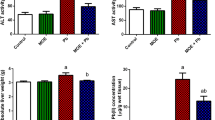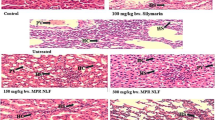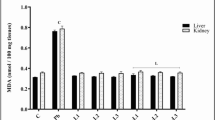Abstract
The aim of this study was to investigate the lead (Pb)-induced lipid metabolism impairment and its amelioration using plant-based therapeutic interventions. Pb-induced hepatotoxicity can disturb the normal levels of natural antioxidant enzymes including glutathione (GSH) and superoxide dismutase (SOD) exerting a crucial impact on membrane unsaturated fatty acids (FA), hence leading to lipid peroxidation. Furthermore, Pb toxicity can also alter the regulation of various hormones involved in the synthesis of 3-hydroxy-methyl glutaryl CoA (HMG-CoA reductase), leading to an impairment in normal levels of serum cholesterol and other associated conjugated lipid molecules such HDL-cholesterol, LDL-cholesterol and VLDL-cholesterol. In this study, the lipoprotein fractions, cholesterol, triglyceride (TGs) and biomarkers of liver functions were estimated by employing respective assay kits. The levels of antioxidant enzymes, FFAs and HMG-CoA reductase were determined by employing sandwich ELISA method. The administration of PbAc in experimental rats induced a significant disturbance in lipid profile (P < 0.05) accompanying a significant reduction in natural antioxidant defence system (P < 0.05). The significant alteration in the levels of serum antioxidant enzymes can lead to membrane lipid peroxidation that is reflected by a significantly (P < 0.05) high level of serum MDA in PbAc-induced experimental rats. However, the administration of resveratrol proved therapeutically effective in the treatment of Pb toxicity. Overall, the results of this study accompanying histopathological examination had proved the ameliorating effect of resveratrol in Pb-induced lipid metabolism impairment by adopting vitamin C as a standard therapeutic intervention.










Similar content being viewed by others
References
Ahamed M, Siddiqui M (2007) Low level lead exposure and oxidative stress: current opinions. Clin Chim Acta 383:57–64
Ahn J, Cho I, Kim S, Kwon D, Ha T (2008) Dietary resveratrol alters lipid metabolism-related gene expression of mice on an atherogenic diet. J Hepatol 49:1019–1028
Aykin-Burns N, Laegeler A, Kellogg G, Ercal N (2003) Oxidative effects of lead in young and adult Fisher 344 rats. Arch Environ Contam Toxicol 44:0417–0420
Batool Z, Yousafzai NA, Murad MS, Shahid S, Iqbal A (2017) Lead toxicity and evaluation of oxidative stress in humans PSM. Biol Res 2:79–82
Bradamante S, Barenghi L, Piccinini F, Bertelli AA, De Jonge R, Beemster P, De Jong JW (2003) Resveratrol provides late-phase cardioprotection by means of a nitric oxide-and adenosine-mediated mechanism. Eur J Pharmacol 465:115–123
Dabak J, Gazuwa S, Ubom G (2009) Hepatoprotective potential of calcium and magnesium against cadmium and lead induced hepatotoxicity in wistar rats. Asian J Biotechnol 1:12–19
Das A (2011) Heat stress-induced hepatotoxicity and its prevention by resveratrol in rats. Toxicol Mech Methods 21:393–399
Dringen R (2000) Metabolism and functions of glutathione in brain. Prog Neurobiol 62:649–671
Du Preez H, Steyn G (1992) A preliminary investigation of the concentration of selected metals in the tissues and organs of the tigerfish (Hydrocynus vittatus) from the Olifants River, Kruger National Park, South Africa. Water SA 18:131–136
Ebuehi O, Ogedegbe R, Ebuehi O (2012) Oral Administration of Vitamin C and Vitamin E amelioratesLead-induced Hepatotoxicity and Oxidative Stress in the Rat Brain. Nigerian Q J Hosp Med 22:85–90
El-Neweshy MS, El-Sayed YS (2011) Influence of vitamin C supplementation on lead-induced histopathological alterations in male rats. Exp Toxicol Pathol 63:221–227
Flora SJ, Flora G, Saxena G (2006) Environmental occurrence, health effects and management of lead poisoning. In: In: Lead. Elsevier, Netherlands, pp 158–228
Highab SM, Muhammad DN, Aliyu M (2016a) Effect of resveratrol on some biochemical parameters in lead-intoxicated male wistar rats. J Adv Med Pharm Sci 5:1–11
Highab SM, Muhammad DN, Aliyu M, Muhammad BY (2016b) Effect of resveratrol on some haematological parameters of lead-intoxicated male wistar rats. J Pharm Res Int 1–7
Highab SM, Aliyu M, Muhammad BY (2017) Effect of resveratrol on liver histopathology of lead-induced toxicity in wistar rats. J Pharm Res Int 1–8
Ijaz MU, Aziz S, Faheem M, Abbas K, Nasir S, Naz H, … & Imran M (2021) Orientin Attenuates Cisplatin-Induced Renal Toxicity by Reducing Oxidative Stress and Inflammation Pakistan. Vet J 41: 574-578
Irshad K, Rehman K, Akash MSH, Hussain I (2021) Biochemical investigation of therapeutic potential of resveratrol against arsenic intoxication. Dose-Response. https://doi.org/10.1177/15593258211060941
Jurczuk M, Brzóska M, Moniuszko-Jakoniuk J (2007) Hepatic and renal concentrations of vitamins E and C in lead-and ethanol-exposed rats. An assessment of their involvement in the mechanisms of peroxidative damage. Food Chem Toxicol 45:1478–1486
Kopin L, Lowenstein CJ (2017) Dyslipidemia. Ann Intern Med 167:ITC81–ITC96
Liu B, Li Y, Mehmood K, Nabi F, Ahmed S, Faheem M, Zhang H (2021) Role of oxidative stress and antioxidants in thiram-induced tibial dyschondroplasia Pakistan. Vet J 41:1–6
Milosevic N, Maier P (2000) Lead stimulates intercellular signalling between hepatocytes and Kupffer cells. Eur J Pharmacol 401:317–328
Mudipalli A (2007) Lead hepatotoxicity & potential health effects. Indian J Med Res 126:518
Murtaza S, Khan JA, Aslam B, Faisal MN (2021) Pomegranate peel extract and quercetin possess antioxidant and hepatoprotective activity against concanavalin A-induced liver injury in mice. Pak Vet J 41:197–202
Namratha ML, Lakshman M, Jeevanalatha M, Kumar BA (2021) Assessment of vitamin c protective activity in glyphosate-Induced hepatotoxicity in rats. Pak Vet J 41:439–445
Newairy A-SA, Abdou HM (2009) Protective role of flax lignans against lead acetate induced oxidative damage and hyperlipidemia in rats. Food Chem Toxicol 47:813–818
Okutan H, Ozcelik N, Yilmaz HR, Uz E (2005) Effects of caffeic acid phenethyl ester on lipid peroxidation and antioxidant enzymes in diabetic rat heart. Clin Biochem 38:191–196
Putics A, Vegh EM, Csermely P, Sőti C (2008) Resveratrol induces the heat-shock response and protects human cells from severe heat stress. Antioxid Redox Signal 10:65–76
Qader A, Rehman K, Akash MSH (2021) Genetic susceptibility of δ-ALAD associated with lead (Pb) intoxication: sources of exposure, preventive measures, and treatment interventions. Environ Sci Pollut Res 1–15
Rauchhaus M et al (2000) Inflammatory cytokines and the possible immunological role for lipoproteins in chronic heart failure. Int J Cardiol 76:125–133
Rehman K, Saeed K, Munawar SM, Akash MSH (2018) Resveratrol regulates hyperglycemia-induced modulations in experimental diabetic animal model. Biomed Pharmacother 102:40–146
Rehman K, Fatima F, Akash MSH (2019) Biochemical investigation of association of arsenic exposure with risk factors of diabetes mellitus in Pakistani population and its validation in animal model. Environ Monit Assess 191:1–15
Sahin K, Orhan C, Akdemir F, Tuzcu M, Iben C, Sahin N (2012) Resveratrol protects quail hepatocytes against heat stress: modulation of the Nrf2 transcription factor and heat shock proteins. J Anim Physiol Anim Nutr 96:66–74
Sayyar HT, Afroz S, Assad T (2021) Evaluation of phytochemical screening antimicrobial and antioxidant activities of ethanol extracts of cucumis flexouses and cucumis reticulatus seeds. Pak Vet J 41:142–146
Sivaprasad R, Nagaraj M, Varalakshmi P (2004) Combined efficacies of lipoic acid and 2, 3-dimercaptosuccinic acid against lead-induced lipid peroxidation in rat liver. J Nutr Biochem 15:18–23
Valenzano DR, Terzibasi E, Genade T, Cattaneo A, Domenici L, Cellerino A (2006) Resveratrol prolongs lifespan and retards the onset of age-related markers in a short-lived vertebrate. Curr Biol 16:296–300
Węsierska-Gądek J, Kramer MP, Maurer M (2008) Resveratrol modulates roscovitine-mediated cell cycle arrest of human MCF-7 breast cancer cells. Food Chem Toxicol 46:1327–1333
Whitsett TG Jr, Lamartiniere CA (2006) Genistein and resveratrol: mammary cancer chemoprevention and mechanisms of action in the rat. Expert Rev Anticancer Ther 6:1699–1706
Xu J, Lian L-J, Wu C, Wang X-F, Fu W-Y, Xu L-H (2008) Lead induces oxidative stress, DNA damage and alteration of p53, Bax and Bcl-2 expressions in mice. Food Chem Toxicol 46:1488–1494
Availability of data and materials
All data generated and/or analysed during this study are included in this published article.
Funding
This work has been financially supported by the research grants (8365/Punjab/NRPU/R&D/HEC/2017) received from the Higher Education Commission of Pakistan.
Author information
Authors and Affiliations
Contributions
AQ was involved in literature search, data curation, experimental analysis, investigation, writing the original draft and validation. KR was responsible for project administration, investigation, conceptualization, writing the final draft and editing. MSHA participated in project administration, supervision, conceptualization, methodology, writing the original draft preparation and editing.
Corresponding author
Ethics declarations
Ethical approval
This study was ethically approved from the Institutional Review Board (GCUF/IRB/4141) of Government College University Faisalabad (GCUF).
Consent to participate
Not applicable.
Consent to publish
Not applicable.
Conflict of interests
The authors declare that they do not have any conflict of interest for this article.
Additional information
Responsible Editor: Gangrong Shi
Publisher’s note
Springer Nature remains neutral with regard to jurisdictional claims in published maps and institutional affiliations.
Rights and permissions
About this article
Cite this article
Qader, A., Rehman, K. & Akash, M.S.H. Biochemical profiling of lead-intoxicated impaired lipid metabolism and its amelioration using plant-based bioactive compound. Environ Sci Pollut Res 29, 60414–60425 (2022). https://doi.org/10.1007/s11356-022-20069-5
Received:
Accepted:
Published:
Issue Date:
DOI: https://doi.org/10.1007/s11356-022-20069-5




